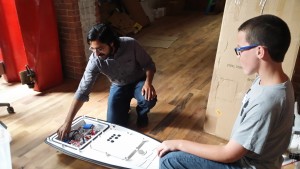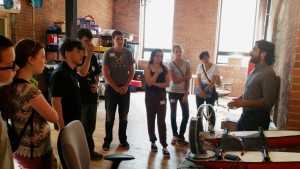 Out of our sixteen tours, the tour of Platypus, LLC was my favorite. Platypus, LLC is a Pittsburgh based company that provides environmental monitoring solutions for water bodies using autonomous robotic boats. Pras Velagapudi, their Chief Technology Officer, was our guide.
Out of our sixteen tours, the tour of Platypus, LLC was my favorite. Platypus, LLC is a Pittsburgh based company that provides environmental monitoring solutions for water bodies using autonomous robotic boats. Pras Velagapudi, their Chief Technology Officer, was our guide.
 He started by explaining how Platypus used a combination of marine, electrical, and software engineering to make their autonomous robotic boats. Marine engineering shaped the hull and kept the boat buoyant. We had an opportunity to examine some of their recent designs created in house with vacuumed formed ABS plastic to form a four foot by two foot floating machine that has a fan on the top. The boat is only 8 inches deep deliberately built to make little environmental impact. The fan can be turned by the motor and controls the direction and propulsion. The design can be made larger or smaller and replicated to allow many robotic boats to work together collecting data.
He started by explaining how Platypus used a combination of marine, electrical, and software engineering to make their autonomous robotic boats. Marine engineering shaped the hull and kept the boat buoyant. We had an opportunity to examine some of their recent designs created in house with vacuumed formed ABS plastic to form a four foot by two foot floating machine that has a fan on the top. The boat is only 8 inches deep deliberately built to make little environmental impact. The fan can be turned by the motor and controls the direction and propulsion. The design can be made larger or smaller and replicated to allow many robotic boats to work together collecting data.They used electrical engineering to connect the sensors, motors, smartphone, and powersource. Engineers used a smartphone as their onboard computer system as a simple used phone can be installed with software to perform monitoring work, serve as the wifi-enabled communication system, an inertia measurement system to measure velocity, orientation, and gravitational forces, and a GPS. The battery of the smartphone can be recharged and sent out for hours of operation at a time.
 Software engineering was needed to program the robotic boats to act autonomously to collect data and not run into each other. Smartphone technology was coupled with an Arduino and programmed with open source software for both the operation of the Platypus robotic boats and the data processing for whatever monitoring the boat is commissioned for. This software is available for download at www.github.com and uses Netbeans for GUI, Eclipse on a Nexus 7 Android phone and C+ + MakeFiles for its firmware.
Software engineering was needed to program the robotic boats to act autonomously to collect data and not run into each other. Smartphone technology was coupled with an Arduino and programmed with open source software for both the operation of the Platypus robotic boats and the data processing for whatever monitoring the boat is commissioned for. This software is available for download at www.github.com and uses Netbeans for GUI, Eclipse on a Nexus 7 Android phone and C+ + MakeFiles for its firmware. The company was formed out of a CMU Robotics Research Group trying to test a platform for their autonomous interactive programming. The CMU roboticists had determined that there were too many obstacles on the ground and struggled to find a good power source for the air. Water robotics gave them the opportunity to avoid harmful collisions and utilize small amounts of energy. Platypus was founded when the roboticists learned of the potential markets and demand for autonomous boats with the environmental testing, fisheries, and flood water monitoring.
The company was formed out of a CMU Robotics Research Group trying to test a platform for their autonomous interactive programming. The CMU roboticists had determined that there were too many obstacles on the ground and struggled to find a good power source for the air. Water robotics gave them the opportunity to avoid harmful collisions and utilize small amounts of energy. Platypus was founded when the roboticists learned of the potential markets and demand for autonomous boats with the environmental testing, fisheries, and flood water monitoring. Pras showed us some of the interesting designs Platypus is producing for varying sized boats. While some of their experimental designs were made out of styrofoam, composite materials shaped by vacuum molds were used to create boats Platypus needed to mass produce.
Pras showed us some of the interesting designs Platypus is producing for varying sized boats. While some of their experimental designs were made out of styrofoam, composite materials shaped by vacuum molds were used to create boats Platypus needed to mass produce.Since Platypus’ mission is to assist the environment, their intellectual property isn’t patented and is available open source. This allows anybody who needs the information to gain access to it, experiment and make changes to the systems as they require.
 Does your child have a research fellows’ project idea that would employ some of Platypus autonomous robotic systems? Apply today for a Grow a Generation Research Fellowship for support and mentorship! Is your school or classroom looking to arrange a STEM Careers Tour to bring to life engineering and STEM curriculum? Contact us to help make plans for your group of students.
Does your child have a research fellows’ project idea that would employ some of Platypus autonomous robotic systems? Apply today for a Grow a Generation Research Fellowship for support and mentorship! Is your school or classroom looking to arrange a STEM Careers Tour to bring to life engineering and STEM curriculum? Contact us to help make plans for your group of students.
